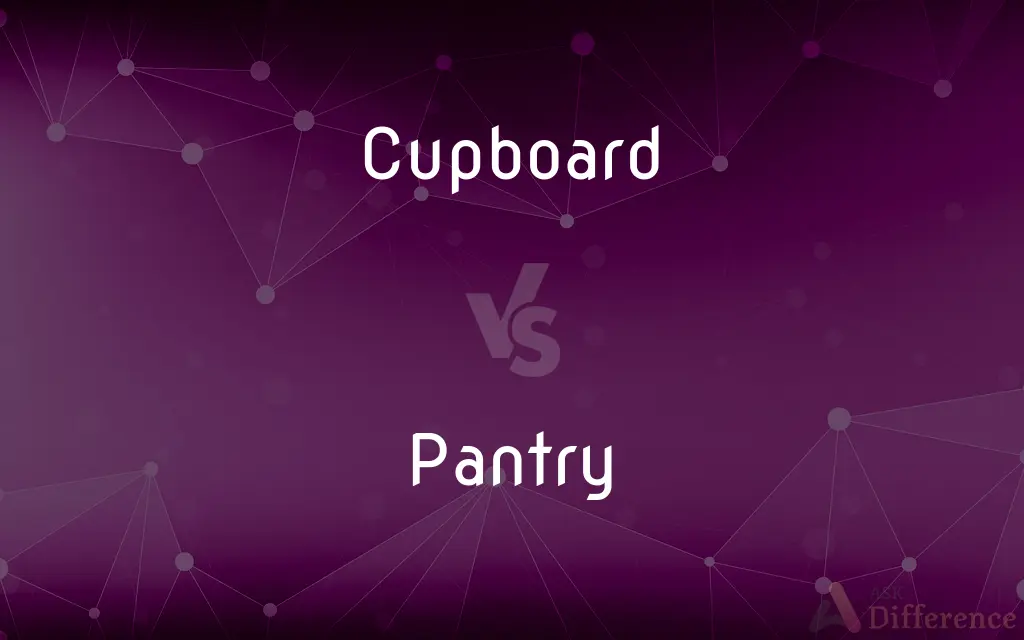Cupboard vs. Pantry — What's the Difference?
By Tayyaba Rehman & Fiza Rafique — Updated on March 29, 2024
A cupboard is a cabinet or closet used for storing dishes or household items, typically found in various rooms, while a pantry is a specific type of cupboard or room dedicated to storing food and kitchen supplies, usually located near the kitchen.

Difference Between Cupboard and Pantry
Table of Contents
ADVERTISEMENT
Key Differences
Cupboards serve as versatile storage units within homes, utilized for organizing dishes, household items, or even clothing, depending on their location and design. Whereas pantries are specialized storage spaces intended primarily for food, ingredients, and sometimes kitchen appliances, emphasizing accessibility and preservation.
Cupboards can be freestanding or built into walls, offering flexibility in design and placement throughout the home, including kitchens, bedrooms, and living rooms. On the other hand, pantries are traditionally located adjacent to kitchens, designed to streamline food storage and preparation processes.
The interior of a cupboard might be simple, with shelves or racks tailored for general storage needs. In contrast, a pantry’s interior is often more meticulously organized, with features like temperature control or specific shelving for various types of food items to maintain freshness.
Cupboards vary widely in size, from small wall-mounted units to large furniture pieces, accommodating a diverse range of items. Pantries, however, tend to be more uniform in their purpose, focusing on food storage, and therefore, their design caters to optimizing space for food items and kitchen essentials.
Material and construction of cupboards can reflect a broad spectrum of styles and purposes, from ornate wooden designs to simple, utilitarian metal or plastic. Pantries typically lean towards practicality, using materials and construction techniques that facilitate cleanliness, visibility, and accessibility of stored food items.
ADVERTISEMENT
Comparison Chart
Purpose
For storing a wide range of household items.
Specifically for storing food and kitchen supplies.
Location
Can be found in various rooms.
Usually located near or in the kitchen.
Design Flexibility
Highly versatile in design.
Focused on food storage efficiency.
Interior Organization
General, with adaptable shelving.
Often specialized for food categories.
Material
Varied, including wood, metal, plastic.
Typically materials that promote cleanliness and preservation.
Compare with Definitions
Cupboard
A closed cabinet for storing household items.
She retrieved the dishes from the kitchen cupboard.
Pantry
Designed for food organization and preservation.
The pantry’s cool temperature kept the vegetables fresh.
Cupboard
Can be freestanding or built into a wall.
The antique freestanding cupboard added charm to their dining room.
Pantry
May include specialized shelving or storage solutions.
The pantry had separate bins for potatoes and onions.
Cupboard
Often made of wood, metal, or plastic.
The metal cupboard in the garage stored all their tools.
Pantry
Often part of a home's kitchen layout.
The modern kitchen design included a hidden pantry door.
Cupboard
Variably sized to fit different spaces.
A small cupboard above the sink held all their spices.
Pantry
A room or closet for storing food and kitchen items.
She stocked the pantry with ingredients for the week.
Cupboard
May have shelves or racks inside.
He organized his clothes neatly in the bedroom cupboard.
Pantry
Typically located near the kitchen.
The walk-in pantry offered ample space for groceries.
Cupboard
A closet or cabinet, usually with shelves for storing food, crockery, and utensils.
Pantry
A pantry is a room where beverages, food, and sometimes dishes, household cleaning chemicals, linens, or provisions are stored. Food and beverage pantries serve in an ancillary capacity to the kitchen.
Cupboard
The term cupboard was originally used to describe an open-shelved side table for displaying dishware, more specifically plates, cups and saucers. These open cupboards typically had between one and three display tiers, and at the time, a drawer or multiple drawers fitted to them.
Pantry
A small room or closet, usually off a kitchen, where food, tableware, linens, and similar items are stored.
Cupboard
(obsolete) A board or table used to openly hold and display silver plate and other dishware; a sideboard; a buffet. 18
Pantry
A small room used for the preparation of cold foods.
Cupboard
(obsolete) Things displayed on a sideboard; dishware, particularly valuable plate. 19
Pantry
See food pantry.
Cupboard
A cabinet, closet, or other piece of furniture with shelves intended for storing cookware, dishware, or food; similar cabinets or closets used for storing other items.
Put the cups back into the cupboard.
Pantry
A small room, closet, or cabinet usually located in or near the kitchen, dedicated to shelf-stable food storage and/or storing kitchenware, like a larder, but smaller.
Cupboard
(obsolete) Things stored in a cupboard; particularly food.
Pantry
(Hong Kong) A break room.
Cupboard
To collect, as into a cupboard; to hoard.
Pantry
An apartment or closet in which bread and other provisions are kept.
Cupboard
A board or shelf for cups and dishes.
Pantry
A small storeroom for storing foods or wines
Cupboard
A small closet in a room, with shelves to receive cups, dishes, food, etc.; hence, any small closet.
Cupboard
To collect, as into a cupboard; to hoard.
Cupboard
A small room (or recess) or cabinet used for storage space
Common Curiosities
How does a pantry differ from a cupboard?
A pantry is specifically designed for storing food and kitchen supplies, often with features for preservation.
Are pantries always separate rooms?
No, a pantry can be a room or a closet-like space within or near the kitchen.
What is the primary function of a cupboard?
To store a wide range of household items, from dishes to clothing.
Can a cupboard be used to store food?
Yes, but it lacks specialized features for food preservation found in pantries.
Is it common to have both cupboards and pantries in a kitchen?
Yes, it's common to use both for different storage purposes within a kitchen.
What materials are cupboards made of?
Cupboards can be made of wood, metal, or plastic, among other materials.
Can pantries help with food organization?
Yes, they are designed with organization and food preservation in mind.
Do all homes have pantries?
Not all, but many homes feature a pantry for efficient food storage.
What is a walk-in pantry?
A pantry large enough that one can walk into it, offering extensive storage space.
How important is location for a pantry?
Very, as it needs to be easily accessible from the kitchen for food preparation.
How do I choose between a cupboard and a pantry?
Consider the specific storage needs; pantry for food, cupboard for general household items.
Can cupboards and pantries be custom-built?
Yes, both can be custom-designed to fit specific spaces and needs.
Do pantries require special features for food preservation?
While not required, features like temperature control can enhance food preservation.
How can the design of a cupboard differ from a pantry?
Cupboards have a more versatile design, while pantries focus on food storage efficiency.
Can a pantry be freestanding?
Yes, though they are more commonly built into the kitchen layout.
Share Your Discovery

Previous Comparison
Wield vs. Yield
Next Comparison
Designate vs. NameAuthor Spotlight
Written by
Tayyaba RehmanTayyaba Rehman is a distinguished writer, currently serving as a primary contributor to askdifference.com. As a researcher in semantics and etymology, Tayyaba's passion for the complexity of languages and their distinctions has found a perfect home on the platform. Tayyaba delves into the intricacies of language, distinguishing between commonly confused words and phrases, thereby providing clarity for readers worldwide.
Co-written by
Fiza RafiqueFiza Rafique is a skilled content writer at AskDifference.com, where she meticulously refines and enhances written pieces. Drawing from her vast editorial expertise, Fiza ensures clarity, accuracy, and precision in every article. Passionate about language, she continually seeks to elevate the quality of content for readers worldwide.















































